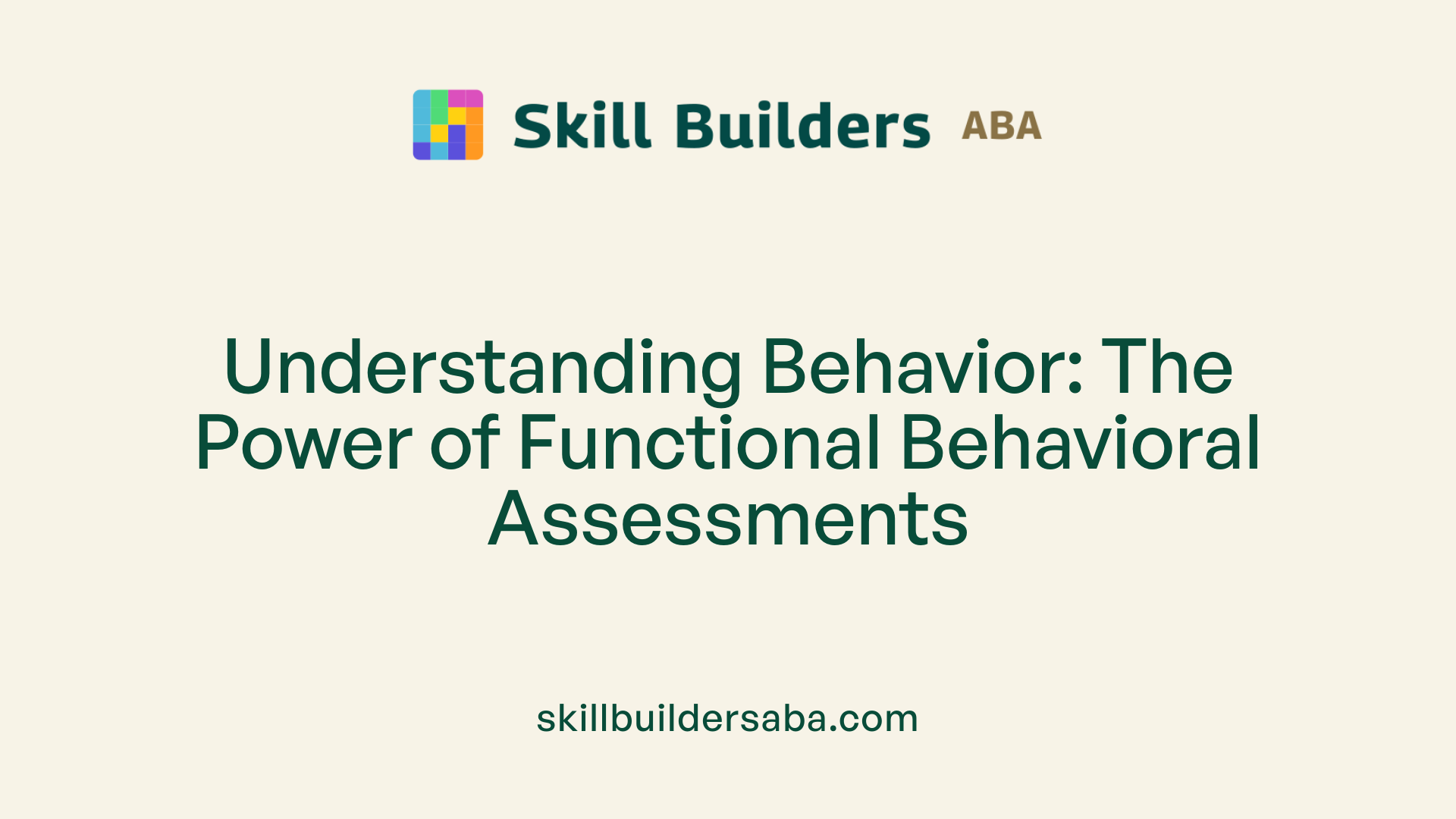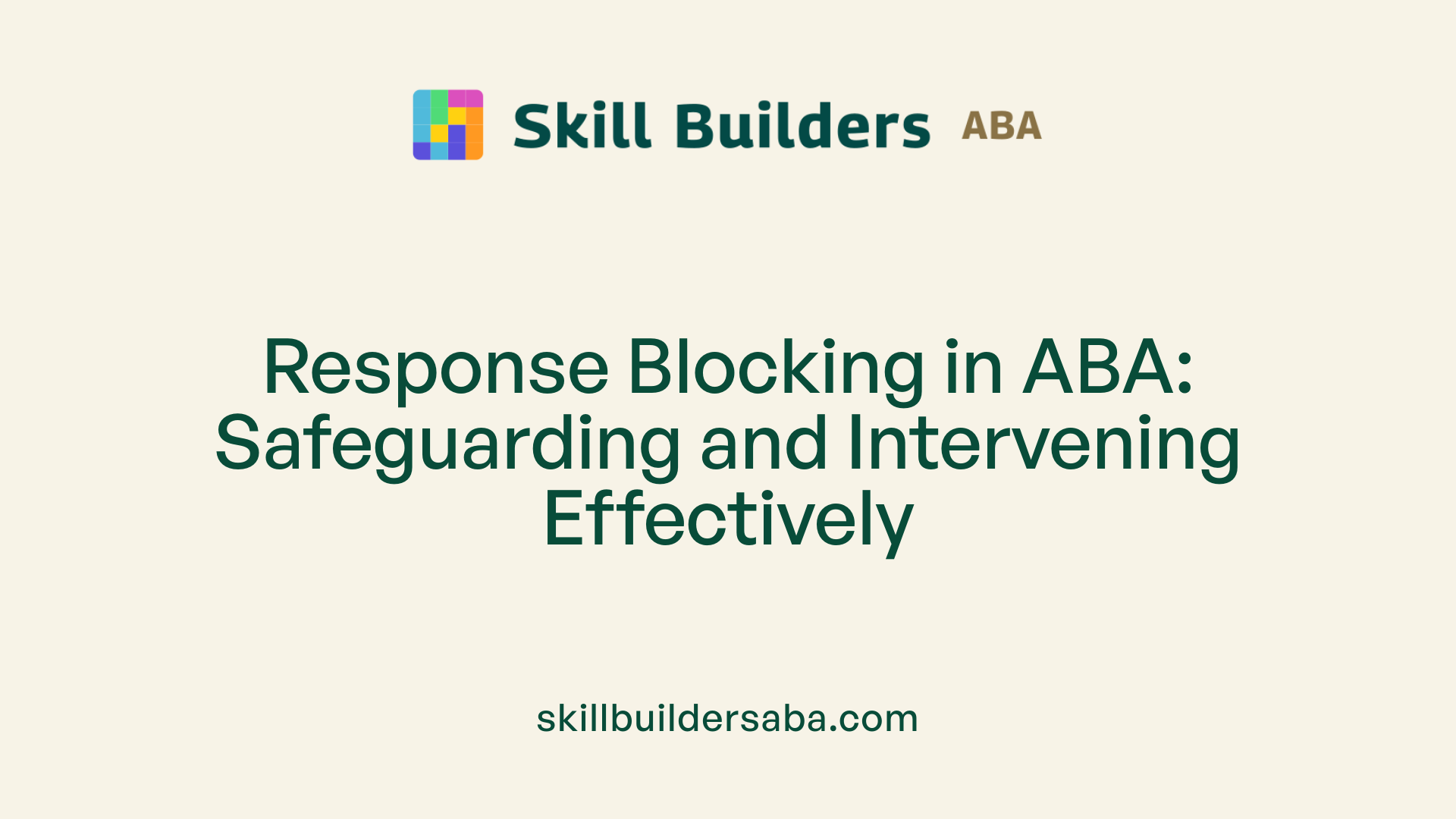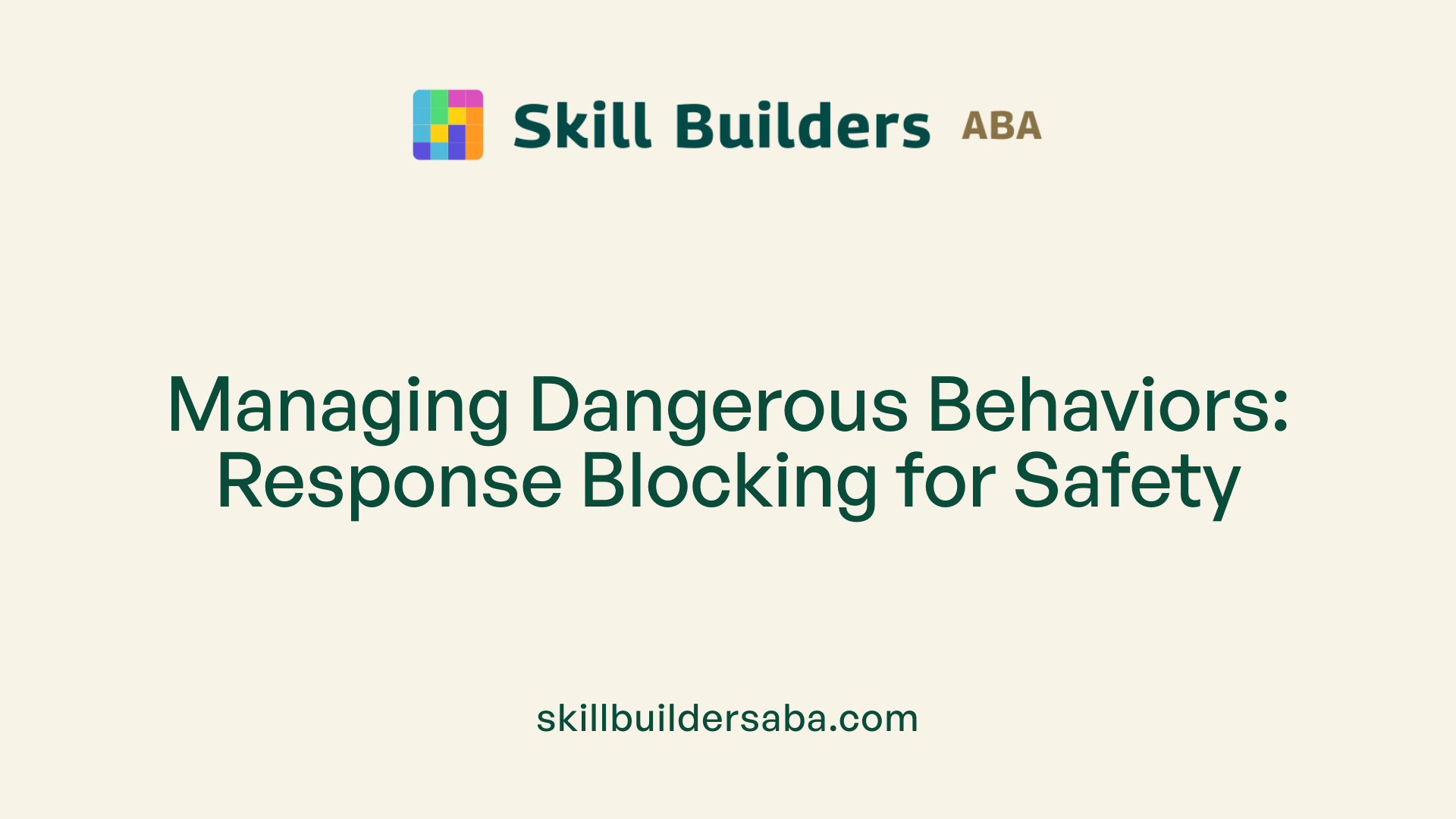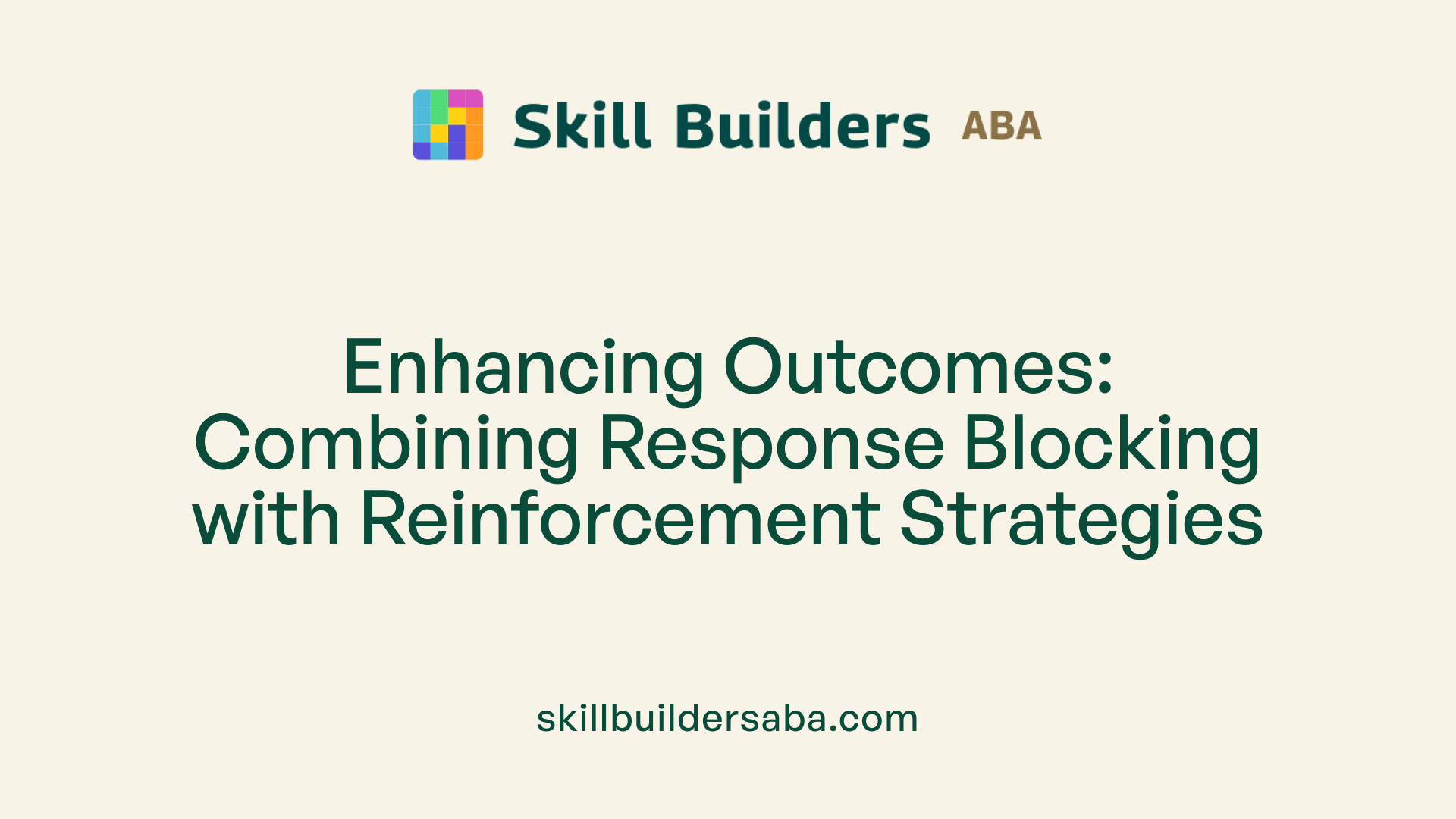
What is response blocking in ABA
Understanding Response Blocking: An Essential ABA Strategy for Behavioral Safety
Introduction to ABA and Behavior Intervention Techniques
Applied Behavior Analysis (ABA) is a well-established discipline aimed at addressing challenging behaviors in individuals with autism spectrum disorder (ASD) and intellectual disabilities (ID). Within this framework, numerous strategies are employed to enhance safety and promote positive behavior change. Response blocking is one such method, critical in preventing and managing unsafe behaviors. This article explores response blocking within the broader context of ABA, emphasizing its purpose, application, and considerations for effective intervention.
Foundations of Applied Behavior Analysis in Addressing Problem Behaviors

What is Applied Behavior Analysis (ABA) and how does it support individuals with autism?
Applied Behavior Analysis (ABA) is a scientific discipline grounded in learning and behavioral principles. It focuses on understanding and modifying observable behaviors by analyzing their antecedents and consequences. ABA is particularly effective in addressing problematic and socially significant behaviors exhibited by children with Autism Spectrum Disorder (ASD) and intellectual disabilities (ID).
Definition and Scope of ABA
ABA encompasses a variety of techniques and interventions aimed at promoting desirable behaviors while reducing harmful or disruptive ones. These strategies can be broadly classified into two categories:
- Comprehensive Approaches: Designed to support global skill development across multiple domains such as communication, social skills, and daily living.
- Problem-Focused Interventions: Target specific problematic behaviors like aggression, self-injury, or repetitive actions.
Role of ABA in ASD and ID
Children with ASD and ID often exhibit complex behaviors that require individualized, function-based interventions. ABA's strength lies in its ability to identify the environmental factors influencing these behaviors through methods like functional behavioral assessments. By understanding the function behind a behavior, tailored treatments—such as extinction, differential reinforcement, or functional communication training—can be effectively applied.
Importance of Evidence-Based Interventions
ABA treatments are empirically validated, ensuring interventions are backed by scientific research. Techniques like functional communication training (FCT), non-contingent reinforcement (NCR), and differential reinforcement have demonstrated success in reducing problematic behaviors including aggression, pica, and elopement. This evidence base fosters confidence in ABA as a reliable and effective approach to behavior management in individuals with ASD and ID.
The Importance of Functional Behavioral Assessment (FBA) in ABA

What is Functional Behavioral Assessment (FBA) and why is it important?
Functional Behavioral Assessment (FBA) is a process grounded in applied behavior analysis (ABA) that seeks to uncover the environmental factors influencing problematic behaviors. It is especially critical for children with autism spectrum disorder (ASD) and intellectual disabilities (ID), where understanding behavior triggers enables the creation of effective, individualized interventions.
Methods of Assessment in FBA
FBA employs several methods to gather relevant data:
- Indirect Assessments: These involve interviews and questionnaires that gather information from caregivers and educators about the behavior.
- Descriptive Observations: Professionals observe the individual in their natural setting to note when and where the behavior occurs.
- Controlled Functional Analysis: This is the most rigorous and scientifically validated method which systematically manipulates environmental variables to identify the function of the behavior.
Role of FBA in Treatment Planning
Determining the specific function of a problem behavior through FBA is essential as it enables practitioners to design function-based treatments. Such treatments may incorporate strategies like extinction (reducing unwanted behavior), non-contingent reinforcement (providing reinforcement independently of the behavior), and functional communication training (teaching alternative communication to replace problematic behavior). This tailored approach enhances treatment effectiveness and promotes positive behavioral outcomes.
Overview of Response Blocking in ABA Therapy

What is response blocking in ABA therapy?
Response blocking is a technique used in Applied Behavior Analysis (ABA) to physically prevent or interrupt unsafe or problematic behaviors before they fully occur. It primarily targets behaviors such as self-injury or stereotypic actions common in individuals with autism spectrum disorder (ASD). This method acts as a form of negative punishment by stopping the behavior and thereby reducing its future occurrence.
What target behaviors does response blocking address?
The behaviors addressed by response blocking usually involve those posing immediate risk to the individual, such as self-injurious behaviors (e.g., hitting oneself, head banging) or dangerous stereotypic behaviors like tooth capping or hand wringing. By intervening as these behaviors begin, therapists help maintain safety while working on more appropriate behavioral alternatives.
How does response blocking work?
Response blocking interrupts the problematic behavior physically, halting its progression and preventing reinforcement from the environment. This helps to reduce the behavior's occurrence by removing the rewarding outcome. To ensure effectiveness and safety, response blocking is part of a broader behavior plan that also includes reinforcement strategies, such as Differential Reinforcement of Alternative Behavior (DRA) or Differential Reinforcement of Other Behavior (DRO), which encourage replacement behaviors.
Overall, response blocking is a critical, empirically supported ABA tool aimed at enhancing safety and reducing dangerous behaviors. It must be executed by specially trained professionals and integrated carefully within comprehensive treatment plans.
Response Blocking as a Component of Comprehensive Behavior Plans
How is response blocking incorporated within broader behavior intervention plans?
Response blocking is a behavioral technique used within applied behavior analysis (ABA) therapy to physically prevent or interrupt unsafe or problematic behaviors, especially those that are self-injurious. However, it does not stand alone as an intervention. Instead, it is integrated into broader, comprehensive behavior plans designed to promote safety and encourage positive behavioral change.
Integration with other ABA strategies
Within comprehensive behavior intervention plans, response blocking is combined with reinforcement and replacement strategies to create a balanced approach. Blocking interrupts the problematic behavior immediately, serving as a form of negative punishment by withholding the opportunity to complete the undesired action. This immediate physical intervention is only conducted by trained professionals well-versed in safety and crisis management.
Relationship with reinforcement and replacement behaviors
To support long-term behavior change, response blocking is paired with strategies such as Differential Reinforcement of Alternative Behavior (DRA) and Differential Reinforcement of Other Behavior (DRO). These strategies reinforce appropriate and safer behaviors, either by encouraging an alternative behavior that achieves the same function as the problematic one or by reinforcing the absence of the problem behavior for set periods.
DRA involves teaching and reinforcing a functionally equivalent behavior, enabling the individual to communicate or act in a safer, more socially acceptable manner. DRO focuses on reinforcing periods where the undesired behavior does not occur, thereby shaping overall reductions in problematic behaviors.
Together, response blocking with DRA and DRO creates a comprehensive plan that not only halts unsafe behaviors but also promotes and reinforces positive alternatives, supporting skill development and safer behavioral outcomes.
Safety Considerations and Professional Training for Response Blocking
Who should implement response blocking and why is professional training necessary?
Response blocking is a specialized technique in ABA therapy that involves physically preventing or interrupting unsafe behaviors like self-injury. Because it requires direct physical intervention, it must only be conducted by trained professionals. These individuals are specifically skilled in safety crisis management to protect both the person receiving intervention and the practitioner.
Professional training is essential to ensure that response blocking is applied ethically and safely. Training helps therapists understand the correct procedures, minimizes potential harm, and integrates response blocking within a comprehensive behavior support plan. It also ensures the intervention aligns with ethical standards and respects individual rights.
The role of trained professionals extends beyond just implementing blocking; it includes recognizing when response blocking is appropriate and combining it with reinforcement strategies such as Differential Reinforcement of Alternative Behavior (DRA) or Differential Reinforcement of Other Behavior (DRO). Such a multidisciplinary approach helps maintain safety while promoting positive behavioral change.
In crisis situations, having skilled personnel who can safely apply response blocking is critical. Properly trained therapists can effectively manage dangerous behaviors, reducing risk and redirecting individuals towards appropriate alternatives, thereby creating a safer environment for everyone involved.
Empirical Support for Response Blocking and Related ABA Procedures
What evidence supports the use of response blocking within ABA?
Applied Behavior Analysis (ABA) incorporates several empirically supported methods to reduce problem behaviors, and response blocking is among these. Research consistently shows that response blocking effectively disrupts dangerous behaviors, particularly in children with autism spectrum disorder and intellectual disabilities. When response blocking is integrated appropriately into treatment plans, it helps in physically interrupting unsafe behaviors like self-injury.
How is response blocking combined with other ABA procedures?
Response blocking is rarely used in isolation. It is combined with function-based interventions such as Functional Communication Training (FCT), extinction, Non-Contingent Reinforcement (NCR), and differential reinforcement strategies. For example, Differential Reinforcement of Alternative behavior (DRA) encourages individuals to learn and use an appropriate behavior that serves the same function as the problematic one. These complementary strategies ensure that while the problematic behavior is blocked, appropriate replacement behaviors are reinforced to promote long-term positive outcomes.
How effective are ABA procedures, including response blocking, on specific problem behaviors?
Studies support the use of response blocking alongside FCT, extinction, NCR, and differential reinforcement to reduce challenging behaviors such as aggression, self-injury, pica, and elopement. The combined approach improves safety and teaching of functional skills. Response blocking specifically targets immediate risk by preventing harmful actions, allowing practitioners to redirect individuals towards safer behaviors. This multifaceted approach ensures comprehensive treatment plans tailored to each individual’s needs, enhancing effectiveness and overall quality of life.
Addressing Self-Injurious and Stereotypic Behaviors Through Response Blocking

What types of problem behaviors can response blocking address?
Response blocking is an effective technique in applied behavior analysis (ABA) therapy specifically designed to manage unsafe self-injurious behaviors (SIB) and stereotypic behaviors. Common examples of these behaviors include head banging and tooth capping, which pose significant risks to the individual's physical health.
How does response blocking work?
This method involves physically preventing or interrupting the behavior before it can be completed or repeated. By doing so, response blocking acts as a form of negative punishment, reducing the chances that the unsafe behavior will occur again. It is crucial that this intervention is only carried out by trained professionals equipped with the necessary skills in safety crisis management.
Considerations and effects of response blocking
Although response blocking has proven effective in decreasing problematic behaviors, research has observed some collateral effects, such as reduced interaction with leisure items and increases in alternative stereotypic behaviors like hand wringing. These side effects, likely due to adventitious punishment, may persist over time but can be somewhat lessened by prompting the individual to access alternative sources of reinforcement.
Role in comprehensive behavior plans
Response blocking is best used as part of a comprehensive behavior management plan, which also incorporates reinforcement strategies such as Differential Reinforcement of Alternative Behavior (DRA) and Differential Reinforcement of Other Behavior (DRO). Together, these interventions not only ensure the individual’s safety but also promote the development of appropriate alternative behaviors.
Potential Side Effects and Collateral Effects of Response Blocking
Are there any unintended effects of response blocking?
Response blocking, while effective at interrupting unsafe or problematic behaviors, may have unintended consequences known as collateral effects. One such effect is adventitious punishment, which occurs when the intervention unintentionally suppresses desirable behaviors. For example, blocking stereotypic behaviors like head and tooth capping has been linked to a reduction in a person's interaction with leisure items. This decrease suggests that the individual may inadvertently avoid engaging with preferred activities due to the blocking procedure.
Moreover, response blocking can sometimes lead to an increase in alternative forms of stereotypic behaviors. Studies have reported rises in behaviors such as hand wringing during blocking interventions. This shift indicates that while one problematic behavior is reduced, others may emerge, possibly as a way for the individual to obtain similar reinforcement.
What about the long-term durability of these side effects?
The undesirable effects of response blocking, including adventitious punishment and increases in alternative stereotypic behaviors, appear to be fairly durable. This durability means that side effects can persist over time if not carefully addressed. However, incorporating strategies like prompting access to alternative sources of reinforcement can help slightly reduce these side effects. This approach encourages the individual to replace blocked behaviors with more appropriate or functional ones.
Given these potential side effects, it is crucial to monitor individuals undergoing response blocking closely. Clinicians should balance the immediate safety benefits of blocking with ongoing assessments to adjust interventions and maintain overall well-being. Effective treatment plans integrate response blocking with reinforcement-based strategies such as Differential Reinforcement of Alternative Behavior (DRA) or Differential Reinforcement of Other Behavior (DRO) to foster positive behavioral changes and minimize unintended outcomes.
Mitigating Side Effects Through Alternative Reinforcement Strategies

How can the side effects of response blocking be reduced?
Response blocking, while effective in interrupting unsafe behaviors in individuals with autism, can sometimes have undesirable side effects. For instance, studies have shown that blocking stereotypic behaviors, like head and tooth capping, may lead to a decrease in interaction with leisure items and an increase in other stereotypic responses such as hand wringing. These collateral effects, referred to as adventitious punishment, result from unintended consequences of the blocking procedure.
One approach to mitigating these side effects involves using prompts to help individuals access alternative sources of reinforcement. By facilitating engagement with preferred activities or reinforcers, prompts encourage positive behavior and reduce reliance on harmful behaviors. This strategy can slightly attenuate the negative impacts of response blocking by maintaining interest in leisure items and reducing the occurrence of other stereotypies.
Incorporating alternative reinforcement, such as Differential Reinforcement of Alternative Behavior (DRA) or Non-Contingent Reinforcement (NCR), alongside response blocking creates a more balanced and effective intervention plan. This combined approach promotes safety while encouraging the development of appropriate, functionally equivalent behaviors.
Overall, the use of prompts to access alternative reinforcement supports a more positive behavioral outcome in ABA therapy and helps ensure that response blocking interventions are both safe and sustainable over time.
Multidisciplinary Approach for Complex Problem Behaviors in ASD
Why is a multidisciplinary approach important in managing problem behaviors in children with ASD?
Due to the complex and multifaceted nature of problem behaviors in children with Autism Spectrum Disorder (ASD), managing these challenges effectively requires a well-rounded approach. A multidisciplinary strategy incorporates not only behavioral assessments and interventions—such as Applied Behavior Analysis (ABA) and Functional Behavioral Assessment (FBA)—but also includes pharmacological and medical evaluations.
The need for behavioral, pharmacological, and medical assessments
Problem behaviors may stem from a variety of biological, psychological, and environmental factors. Behavioral assessments help identify antecedents and consequences shaping these behaviors and guide targeted behavioral treatments. However, some behaviors may have underlying medical conditions or may be influenced by medications. Including pharmacological and medical assessments helps identify such biological components, ensuring that treatment plans reflect the full scope of needs and promote overall health and safety.
Collaboration between professionals
Effective treatment requires collaboration among a team of professionals, including behavior analysts, medical practitioners, psychologists, and pharmacologists. This collaboration fosters information sharing and coordinated care, reducing gaps between interventions and monitoring possible side effects or changes in medical status.
Holistic treatment planning
Integrating diverse professional insights leads to individualized, function-based treatment plans that prioritize both safety and behavior change. Treatment can include behavioral methods like extinction, differential reinforcement, functional communication training, and response blocking while considering medication management and health monitoring. Such holistic planning improves the chances of reducing problematic behaviors while supporting the child’s wellbeing across home, school, and therapy settings.
Adopting a multidisciplinary approach acknowledges that problem behaviors in ASD are rarely influenced by a single factor, and comprehensive, coordinated interventions are essential for effective, sustained outcomes.
Consistency and Generalization of Behavior Interventions Across Settings
How important is consistency in implementing response blocking and related ABA interventions?
Supporting individuals with autism spectrum disorder who engage in unsafe behaviors, such as self-injurious behavior (SIB), demands consistent implementation of behavioral strategies across multiple environments, including home, school, and therapy settings. This uniformity is crucial to maintaining safety, reinforcing learned behaviors, and promoting the generalization of these behaviors beyond controlled therapy sessions.
Consistency ensures that the interventions, particularly those involving response blocking and other ABA techniques, are applied reliably and systematically. This reliability helps the individual recognize and respond predictably to behavioral expectations, reducing confusion and enhancing skill acquisition.
Moreover, consistent application across environments facilitates the transfer of appropriate behaviors from one setting to another, which is essential for sustained behavioral change. Without coordination among caregivers, educators, and therapists, interventions might be less effective or inconsistently applied, potentially undermining progress.
Supporting sustained behavior change also involves comprehensive assessment to understand the function of problem behaviors, enabling individualized plans that integrate safe and functional replacement behaviors. This approach prioritizes safety while addressing the root causes of challenging behaviors, reinforcing new skills through reinforcement strategies like Differential Reinforcement of Alternative Behavior (DRA) and Differential Reinforcement of Other Behavior (DRO).
In summary, consistency across all environments not only promotes safety but is foundational for effective, long-lasting behavior intervention outcomes for children with ASD and related challenges.
Summary: The Role of Response Blocking in Ensuring Safety and Behavior Change
What is the overall role of response blocking in ABA therapy?
Response blocking is a behavioral intervention technique widely used within applied behavior analysis (ABA) therapy to physically interrupt unsafe or problematic behaviors, such as self-injurious actions or stereotypic behaviors observed in individuals with autism spectrum disorder (ASD). Its primary purpose is to maintain a safe environment by preventing the completion of harmful responses before they can cause injury.
This intervention is a form of negative punishment, where the behavior is stopped through physical intervention and redirecting the individual toward safer, more appropriate behaviors. It must be implemented strictly by trained professionals equipped in safety crisis management to ensure ethical and effective application.
Role in maintaining safety
Response blocking serves as an immediate safety measure for behaviors that pose a physical threat, such as head banging or tooth capping. It interrupts these behaviors quickly to reduce harm, making it a vital component in comprehensive behavioral plans. However, response blocking should not stand alone. It is integrated with reinforcement-based strategies like Differential Reinforcement of Alternative Behavior (DRA) and Differential Reinforcement of Other Behavior (DRO) to teach and strengthen appropriate replacement behaviors.
Importance of individualized, functional interventions
Effective use of response blocking is contingent on thorough functional behavioral assessment (FBA). By identifying the environmental factors and functions maintaining the problem behaviors, clinicians can develop individualized, function-based treatment plans. These plans focus on safety while also addressing the underlying cause of the behavior through extinction, functional communication training, and reinforcement techniques. Consistency across home, school, and therapy settings is crucial for generalizing desired behavior change and ensuring ongoing safety.
Potential side effects and their management
While response blocking can reduce dangerous behaviors, studies have shown it may produce unintended side effects, such as reduced engagement with leisure activities or increases in other stereotypic behaviors. These collateral effects are thought to arise from adventitious punishment — unintended negative consequences of the intervention. Incorporating prompts to encourage access to alternative reinforcement sources can help mitigate these side effects, though some effects may be durable over time.
| Aspect | Description | Additional Notes |
|---|---|---|
| Response Blocking Role | Physically interrupts unsafe behaviors to maintain safety | Used only by trained professionals |
| Integration with Other Strategies | Combined with DRA and DRO to reinforce replacement behaviors | Essential for long-term success |
| Functional Assessment | Informs individualized intervention plans | FBA is critical for understanding behavior functions |
| Side Effects | May reduce leisure engagement or increase other stereotypies | Use of prompts and reinforcement can attenuate effects |
| Safety Priority | Central in intervention to protect individuals from harm | Comprehensive behavior plans emphasize safety and function-based treatment |
Conclusion and Future Considerations
Response blocking is a valuable and empirically supported technique within the ABA framework that focuses on preventing unsafe problem behaviors, particularly self-injury and stereotypy, through direct physical interruption. While effective, it requires careful implementation by trained professionals and must be integrated with reinforcement-based strategies to address side effects and promote positive behavior change. A comprehensive, multidisciplinary approach and consistent application across settings optimize outcomes for individuals with ASD and other developmental disabilities. Continued research and clinical vigilance will improve the balance between safety and the promotion of meaningful, functional skills.
References
Reach Out Today
Learn more about how we can support your child’s growth and development. Contact us to discuss our services and availability in your area.
.svg)